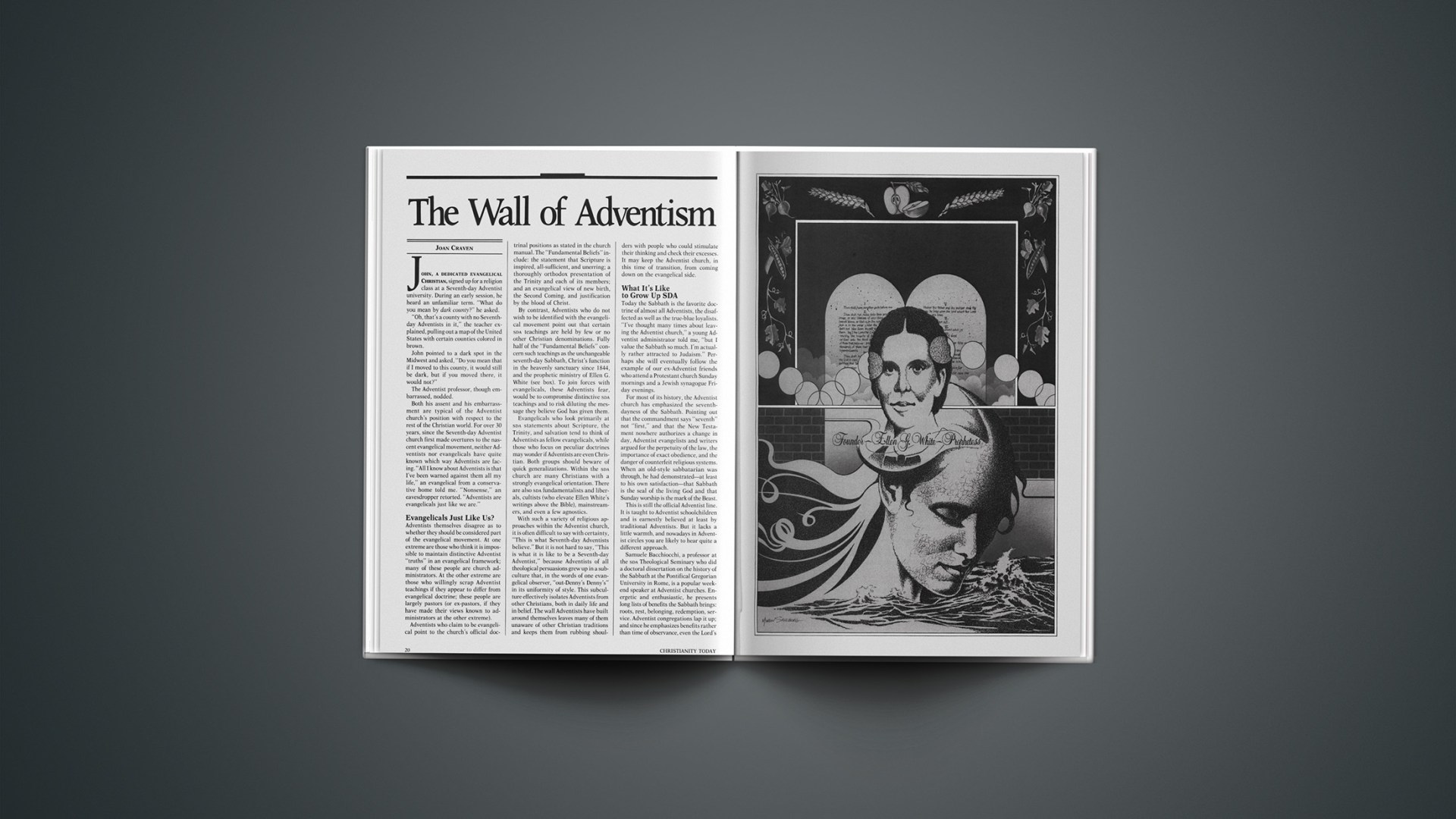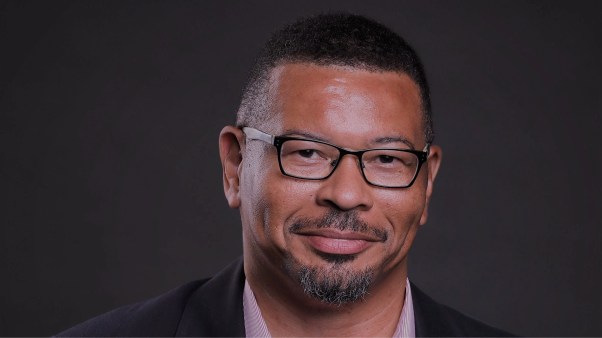John, a dedicated evangelical Christian, signed up for a religion class at a Seventh-day Adventist university. During an early session, he heard an unfamiliar term. “What do you mean by dark county?” he asked.
“Oh, that’s a county with no Seventh-day Adventists in it,” the teacher explained, pulling out a map of the United States with certain counties colored in brown.
John pointed to a dark spot in the Midwest and asked, “Do you mean that if I moved to this county, it would still be dark, but if you moved there, it would not?”
The Adventist professor, though embarrassed, nodded.
Both his assent and his embarrassment are typical of the Adventist church’s position with respect to the rest of the Christian world. For over 30 years, since the Seventh-day Adventist church first made overtures to the nascent evangelical movement, neither Adventists nor evangelicals have quite known which way Adventists are facing. “All I know about Adventists is that I’ve been warned against them all my life,” an evangelical from a conservative home told me. “Nonsense,” an eavesdropper retorted. “Adventists are evangelicals just like we are.”
Evangelicals Just Like Us?
Adventists themselves disagree as to whether they should be considered part of the evangelical movement. At one extreme are those who think it is impossible to maintain distinctive Adventist “truths” in an evangelical framework; many of these people are church administrators. At the other extreme are those who willingly scrap Adventist teachings if they appear to differ from evangelical doctrine; these people are largely pastors (or ex-pastors, if they have made their views known to administrators at the other extreme).
Adventists who claim to be evangelical point to the church’s official doctrinal positions as stated in the church manual. The “Fundamental Beliefs” include: the statement that Scripture is inspired, all-sufficient, and unerring; a thoroughly orthodox presentation of the Trinity and each of its members; and an evangelical view of new birth, the Second Coming, and justification by the blood of Christ.
By contrast, Adventists who do not wish to be identified with the evangelical movement point out that certain SDA teachings are held by few or no other Christian denominations. Fully half of the “Fundamental Beliefs” concern such teachings as the unchangeable seventh-day Sabbath, Christ’s function in the heavenly sanctuary since 1844, and the prophetic ministry of Ellen G. White (see box). To join forces with evangelicals, these Adventists fear, would be to compromise distinctive SDA teachings and to risk diluting the message they believe God has given them.
Evangelicals who look primarily at SDA statements about Scripture, the Trinity, and salvation tend to think of Adventists as fellow evangelicals, while those who focus on peculiar doctrines may wonder if Adventists are even Christian. Both groups should beware of quick generalizations. Within the SDA church are many Christians with a strongly evangelical orientation. There are also SDA fundamentalists and liberals, cultists (who elevate Ellen White’s writings above the Bible), mainstreamers, and even a few agnostics.
With such a variety of religious approaches within the Adventist church, it is often difficult to say with certainty, “This is what Seventh-day Adventists believe.” But it is not hard to say, “This is what it is like to be a Seventh-day Adventist,” because Adventists of all theological persuasions grew up in a subculture that, in the words of one evangelical observer, “out-Denny’s Denny’s” in its uniformity of style. This subculture effectively isolates Adventists from other Christians, both in daily life and in belief. The wall Adventists have built around themselves leaves many of them unaware of other Christian traditions and keeps them from rubbing shoulders with people who could stimulate their thinking and check their excesses. It may keep the Adventist church, in this time of transition, from coming down on the evangelical side.
What It’S Like To Grow Up Sda
Today the Sabbath is the favorite doctrine of almost all Adventists, the disaffected as well as the true-blue loyalists. “I’ve thought many times about leaving the Adventist church,” a young Adventist administrator told me, “but I value the Sabbath so much. I’m actually rather attracted to Judaism.” Perhaps she will eventually follow the example of our ex-Adventist friends who attend a Protestant church Sunday mornings and a Jewish synagogue Friday evenings.
For most of its history, the Adventist church has emphasized the seventh-dayness of the Sabbath. Pointing out that the commandment says “seventh” not “first,” and that the New Testament nowhere authorizes a change in day, Adventist evangelists and writers argued for the perpetuity of the law, the importance of exact obedience, and the danger of counterfeit religious systems. When an old-style Sabbatarian was through, he had demonstrated—at least to his own satisfaction—that Sabbath is the seal of the living God and that Sunday worship is the mark of the Beast.
This is still the official Adventist line. It is taught to Adventist schoolchildren and is earnestly believed at least by traditional Adventists. But it lacks a little warmth, and nowadays in Adventist circles you are likely to hear quite a different approach.
Samuele Bacchiocchi, a professor at the SDA Theological Seminary who did a doctoral dissertation on the history of the Sabbath at the Pontifical Gregorian University in Rome, is a popular weekend speaker at Adventist churches. Energetic and enthusiastic, he presents long lists of benefits the Sabbath brings: roots, rest, belonging, redemption, service. Adventist congregations lap it up; and since he emphasizes benefits rather than time of observance, even the Lord’s Day Alliance praises his work.
On a more sophisticated level, Niels-Erik Andreasen of Loma Linda University has written several scholarly books about the biblical Sabbath. He also emphasizes the day’s quality rather than its sequence in the week; the relationship of Sabbath to use of time, attitude toward work, care of the poor, and worship rather than belaboring the fate of those who fail to observe the Sabbath as Adventists do.
Bacchiocchi and Andreasen are the most prominent among a growing body of Adventist theologians who are turning their attention to the meaning of the Sabbath. Even Desmond Ford, leader of those Adventists who are pushing for a Reformed theology, extols seventh-day Sabbath keeping in his self-published book, The Forgotten Day. And the Association of Adventist Forums, a group of university-educated Adventists that is frequently reprimanded by the general conference, devoted an entire issue of their journal Spectrum to exploring the virtues of the Sabbath.
Holy Time
An Adventist Sabbath, like its Jewish predecessor, begins at sundown Friday night. The house is clean; the Sabbath dinner is cooked, Handiwrapped, and waiting in the refrigerator. The children have had their baths, and a traditional Friday-night supper may be on the table. The family gathers in the living room for worship. Sabbath has begun.
On the Sabbath, the secular world is shut out as much as possible. Money is handled only when the offering plate is passed. If you run out of milk, you go without; and if you plan to go to the zoo, you either get a season pass or buy your tickets in advance. Since Sabbath commemorates Creation, nature study is acceptable; you can walk on the beach or sort your butterfly collection. Sports and schoolwork are out, however; don’t take your surfboard to the beach, and leave your butterflies alone if they’re for a class project.
Unnecessary work is out. It is best to work for an Adventist company, because you will be let off work early on Friday. If you work for any other organization, you must ask to leave in time to be home by sundown, even in late December.
Reading should be restricted to God and nature; the Bible and Ellen White’s books are best. Children may play quiet games if they have a biblical emphasis. Some families have a special box of “Sabbath toys” that are brought out only once a week. I once asked if I might play “Bible Ping-Pong”; I promised to say a verse of Scripture with every serve. My parents did not fall for the idea.
Sabbath dinner is the best of the week. Guests are frequently invited. A typical company dinner includes a vegetarian entree, scalloped or baked potatoes, a vegetable or two, an individually molded Jello salad, rolls, fruit punch, and a dessert. After dinner the family and friends sit around the living room and spend the evening talking.
The Sabbath tradition permeates much more than 24 hours a week. Concern for proper Sabbath keeping motivates not only job choice but also choice of schools, recreation, friends, location. Sabbath is more than a day of rest; it is a way of life that for most Adventists is more fulfilling than restrictive. No wonder disenchanted Adventists hate to give it up. The rest of Christendom has nothing to put in its place.
But important as it is, Sabbath is only one aspect of the Adventist world. The SDA subculture wraps all of life in its protective blanket. Two distinctive features of the SDA lifestyle go beyond Sabbath observance in separating Adventists from other Christians: the church’s educational system and SDA eating habits.
Train Up A Child
“When I leave the Adventist church,” a friend told me, “I imagine my best friends will still be Adventists and ex-Adventists. They understand me. It’s too hard to have to explain myself all the time to everyone else.”
Anyone who has grown up in a close-knit subculture knows it is impossible ever to shake it off completely. Chaim Potok’s heroes agonize; Peter De Vries’s people repudiate; Mary McCarthy’s laugh—but nobody forgets. Adventists are like each other, and different from everyone else, in a pattern of observances and relationships that may go underground, but resolutely refuses to disappear.
For little Adventists, subcultural patterns are created and reinforced by the extensive SDA educational system. Six-year-olds act out eschatological dramas and 12-year-olds memorize proof texts along with other children who eat, drink, play, read, dress, worship, and witness very much as they do themselves. By the time an Adventist student graduates from academy (high school), he has piled up over 1,500 hours of formal religious instruction, not counting church time.
Religious education continues on Saturdays in the church’s well-organized Sabbath-school program, often called “the church at study.” Sabbath-school activities are carefully planned for all ages, and the children’s rooms are decorated like department store windows.
Although younger children are led in vigorous songs and activities, they do not spend Sabbath-school time on crafts, and few churches have nurseries that provide child care and nothing else. From infancy, children come to Sabbath school to learn.
The Adventist educational system does a lot more than teach theology to children. For one thing, it ensures that SDAS will be part of a network with connections everywhere. When I was 14 years old, a speaker gave a chapel talk at my academy on the topic, “What I like about being an Adventist.” She told about a round-the-world trip she had recently taken. At every port, she and her husband were met by Adventists who welcomed them, fed them, and showed them around. Other passengers watched, amazed, thinking a celebrity must be in their midst. Her experience was not unusual. It can happen to any Adventist affiliated with one of the church’s educational or medical institutions.
Another accomplishment of the SDA educational system is its perpetuation of the Adventist lifestyle. Like other Christian groups with roots in the nineteenth-century American holiness movement, Adventists are not supposed to dance, play cards, or go to movies. In one area, however, Adventists go far beyond their frontier for bears. No group but the Jews surpasses the Seventh-day Adventist church in its dietary requirements.
Touch Not, Taste Not
Adventists, like many other Christians, do not drink, smoke, or use recreational drugs. However, Adventists are also taught not to drink tea, coffee, or caffeinated soda pop; to avoid meat, fish, and poultry; and to stay completely clear of pork or shellfish. In addition, a few Adventists avoid eggs and dairy products, eat their main meal in the morning, and do not drink liquids of any kind with their meals.
These dietary habits derived from the recommendations and edicts of Ellen White, who was strongly influenced by nineteenth-century health-reform movements. They have led to an SDA-owned food industry specializing in imitation meats made from wheat gluten or soybean products; and they have changed American eating habits: both dry breakfast cereal and peanut butter were inspired by the health-reform teachings of the SDA sanitarium at Battle Creek, Michigan.
The hardest dietary rule for many Adventists to break is the prohibition against eating pork. Although based on Old Testament food laws (Lev. 11), their diet regulations, SDAS maintain, are not religious prohibitions but health measures. Nevertheless, one SDA seminary professor proudly told his students of relatives who died in a concentration camp rather than eat the daily stew, which always had pork in it.
For some Adventists, dietary beliefs seem more important not only than health but also than other moral standards. If SDA students are going to transgress, they are more likely to drink beer than to have pepperoni on their pizza. A high-school girl told my husband that she feels just as guilty when she eats a hot dog as when she goes to bed with her boyfriend. No doubt an Ellen White statement that is often quoted to SDA grade-school students is responsible for this elevation of dietary law to moral imperative: “Among those who are waiting for the coming of the Lord, meat eating will eventually be done away; flesh will cease to form a part of their diet” (Counsels on Diet and Foods, pp. 380–81).
Because of these food habits, Adventist students in public school can have a hard time. When the gang goes to McDonald’s, they settle for French fries and a carton of milk. Food intake is limited at parties; and accepting an invitation to a friend’s house can lead to embarrassment all around. Of course, for most Adventist kids this problem is purely academic—they don’t go to public school. As a five-year-old friend of ours explained, “I can’t go to public school, because I can’t eat meat.”
The apostle Paul recognized that dietary laws and enforced holy days can separate people for whom Christ died. Seventh-day Adventists don’t seem to mind the separation. In some cases, they invite it.
A Dividing Wall
Several years ago, leaders of the Inter-Varsity chapter at a private liberal arts college invited students from a nearby Adventist college to join them for Bible study. Administrators at the Adventist college considered the proposal.
On the one hand, it looked attractive. Adventist college students do not have much contact with the world beyond their campus. The Inter-Varsity students were obviously good kids, interested in the Scriptures. Perhaps some of them could even be won to Adventism. But on the other hand, college students are attracted to members of the opposite sex. What if one of the Adventist students began dating one of the Inter-Varsity students? What if a “mixed-marriage”—one between an Adventist Christian and a Christian of another denomination—should take place as the result of a college-sponsored program?
The Adventist campus chaplain sent his regrets to the Inter-Varsity Christian Fellowship leaders.
For all their talk about being evangelical Christians, Adventists still consider themselves superior to the others. “How can you leave the Adventist church?” someone asked me several years ago. “We have so much more than they do.” For an Adventist, the “something more” is not just a nice option. It is essential.
Officially, Adventists believe that other Christians can be saved—“if they are living up to the light they have,” one often hears. Only the Adventist church has “the truth,” but God understands that Satan has so distorted God’s requirements that most Christians, like ten-year-olds, cannot be held fully accountable for their misperceptions.
“The truth” usually means observance of the seventh-day Sabbath. According to Adventist mythology, almost all Christians kept Sabbath until the time of Constantine, when pagan Rome gave its authority to the Roman church. In the fourth and fifth centuries, Sabbath keeping died out in the official church. Only in remote areas did brave Christians continue to obey the commandments of God; these saints were persecuted whenever discovered. After more than a thousand years of neglect, the Sabbath did not make a general comeback with the Reformation. But the Word became once again accessible, and Bible students discovered for themselves the truth about the seventh-day Sabbath. In the nineteenth century, the Seventh-day Adventist Church arose to reestablish the Sabbath truth in order to prepare a people for the Second Coming. In the last days, the saints will keep all the commandments of God (Rev. 12:17).
Adventist historians no longer teach this version of early church history: they are well aware that seventh-day Sabbath observance was practically unknown among second-century Christians. But although the story has changed, the interpretation has not. Says Mervyn Maxwell, professor of church history at the SDA Theological Seminary, “The speed with which early Christianity tobogganed into apostasy takes one’s breath away.”
Apostate Protestantism
Maxwell did not say apostasy for effect only. Apostate Protestantism is Ellen White’s term for Protestant churches that worship on Sunday. According to Adventist eschatology, in time the Sabbath issue will be so clear that God’s people will swarm out of the apostate churches (“Babylon the great is fallen.… Come out of her, my people,” Rev. 18:2–4) and will join those who keep the seventh-day Sabbath. Until that day, God will overlook their ignorance unless they refuse to see truth when it is presented to them.
I do not think this view of Sabbath is strong among university-educated, lifetime Adventists under 50. It has a strong grip, however, on most other Adventists—the late-middle-aged and elderly, new converts of all ages, church administrators, rank-and-file church members. It is, after all, clearly and persistently taught by Ellen White. It forms the basis for the Adventist missionary effort.
In SDA terminology, a “convert” is a person who becomes an Adventist, even if he has been a Christian for years. It is possible to “witness” to other evangelical Christians, because they do not understand the “full message.” When I announced plans to work for an interdenominational Christian organization, several people said, “What a wonderful opportunity to do missionary work.” They were not thinking of the unchurched people to whom my organization reaches out, but of the Christians I would be working with.
After all, according to the SDA church manual, “in the last days, a time of widespread apostasy, a remnant has been called out to keep the commandments of God and the Faith of Jesus” (p. 37). Before baptizing a convert, the minister asks, “Do you believe that the Seventh-day Adventist Church is the remnant church of Bible prophecy?” The candidate is expected to say yes, and members are expected to continue saying yes. To leave the remnant church of Bible prophecy, in the minds of traditional Adventists, is to reject God’s offer of grace and, ultimately, salvation.
Leaving The Church
Says a former Adventist, now active in another Protestant church, “It was always presented to me in Bible Doctrines [the eleventh-grade religion course] that if you left the church, it was because you wanted to be a sinner. You either were in the true church or none at all, because you couldn’t find any other that would satisfy you. But the people I know who have left are now deeply committed to some other denomination.” Their families, though, often still operate according to the either-or mentality. This woman’s aunt commented to her cousin, “Isn’t it too bad they’re raising their child without any religious training.” (The child is actively involved in church educational programs.)
Most former Adventists, even if they are still committed Christians, collect comments from family members who sincerely fear for their salvation. “God will save people who live up to the light they have,” one mother said. “You know the truth, and you have rejected it.”
“Your leaving the church is harder for me to face than your father’s death,” another mother said.
A father wailed, “It’s just not possible to worship in another church when you know how the Devil has polluted their teachings and practices.”
In sum, as one parent said, “You surely don’t believe in the Bible anymore, because if you did you would know that Adventism is the only truth.” And in the words of another parent, “A cloud has settled down over our lives that can never be lifted.”
Can Adventists And Evangelicals Work Together?
The Seventh-day Adventist doctrines and subculture have isolated church members from the rest of Christendom. Many Adventists have so little contact with other Christians that they honestly believe the Adventist church alone has not bowed the knee to Baal. And even those Adventists who no longer believe the Adventist church to be “the remnant church of Bible prophecy” often find themselves at sea once they pass the borders of their subculture. As a middle-aged college religion teacher—recently fired for alleged lack of loyalty to denominational perspectives—said, “I don’t think I’ll leave the Adventist church. This is where I’ve spent my whole life. My family and friends are Adventists. I’m comfortable here. But I don’t know where I’m going to find a job.”
Yet there are more contacts between Adventist and other Christians today than there were several decades ago. A few SDA scholars have published books with Christian publishers who are not Adventists—for example, Gerhard Hasel on Old Testament theology, Walter Specht and Sakae Kubo on Bible translations, and Kubo on Greek vocabulary. In turn, Adventists are reading evangelical books. The Andrews University Bookstore, which serves an Adventist college, graduate school, and seminary, is one of InterVarsity Press’s top academic customers.
Although tenured professors at Adventist colleges are still required to be Adventist church members in good standing, occasionally an evangelical organization hires an Adventist. “We have no problem with your church affiliation,” the director of one such company recently told a newly hired Adventist, “so long as you don’t proselytize at work.” (He hasn’t.)
And although most people who leave the Adventist church wound their parents deeply, some parents surprise their children with their openness. One of the staunchest and strictest Adventist fathers I have ever met recently said to his daughter, who plans to join the Episcopal church in spring, “The denomination you belong to doesn’t matter. What matters is if you love Jesus.”
Committed to the Christ of the Scriptures, and to the authority of God’s Word, a growing number of “ecumenical” Adventists appears ready—if not entirely able—to move into a more open fellowship with the broader evangelical community. Such boldness demands our encouragement; and can ultimately enrich both groups.
However, the wall of Adventism is formidable. And we will not know if it is impregnable until SDA leaders and laity are willing to address critically the barriers of legalism in the context of a truly evangelical faith.
Tim Stafford is a free-lance writer living in Santa Rosa, California. He is a distinguished contributor to several magazines. His latest book is Do You Sometimes Feel Like a Nobody? (Zondervan, 1980).










